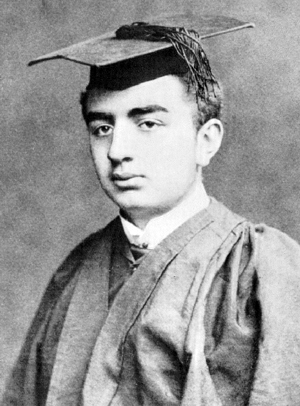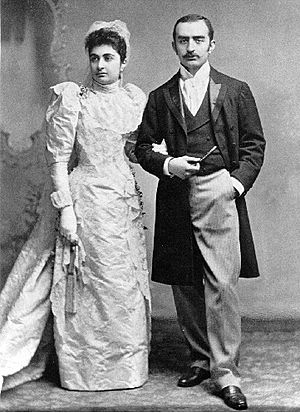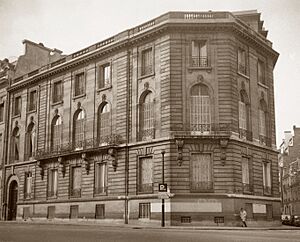Calouste Gulbenkian facts for kids
Quick facts for kids
Calouste Gulbenkian
|
|
|---|---|
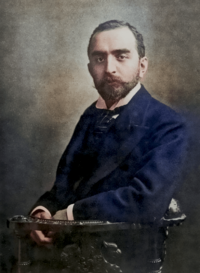
Gulbenkian in the 1890s
|
|
| Born |
Calouste Sarkis Gulbenkian
23 March 1869 |
| Died | 20 July 1955 (aged 86) Lisbon, Portugal
|
| Resting place | St. Sarkis Armenian Church, London |
| Citizenship | British (from 1902) Ottoman |
| Alma mater | King's College London |
| Occupation | Petroleum engineer |
| Years active | 1895–1955 |
| Organization | Turkish Petroleum Company Iraq Petroleum Company |
| Spouse(s) | Nevarte Essayan |
| Children | Nubar Sarkis (1896–1972) Rita Sivarte (1900–1977) |
| Parent(s) | Sarkis and Dirouhie Gulbenkian |
| Signature | |
 |
|
Calouste Sarkis Gulbenkian (/kæˈluːst ɡʊlˈbɛŋkiən/, Western Armenian: Գալուստ Կիւլպէնկեան; 23 March 1869 – 20 July 1955) was a British-Armenian businessman and a very generous giver (philanthropist). People often called him "Mr Five Per Cent". He played a big part in making the Middle East's oil available to the world. He was also the first person to develop oil in Iraq. Gulbenkian traveled a lot and lived in cities like Istanbul, London, Paris, and Lisbon.
Throughout his life, Gulbenkian helped many people and causes. He supported schools, hospitals, and churches. After he passed away, the Calouste Gulbenkian Foundation was created in 1956. This foundation, based in Portugal, continues to support arts, charity, education, and science globally. It is now one of the largest foundations in Europe. By the end of his life, he was one of the richest people in the world. His collection of art was also one of the greatest private collections ever.
| Top - 0-9 A B C D E F G H I J K L M N O P Q R S T U V W X Y Z |
Discovering Calouste Gulbenkian
Early Life and Family History
Calouste Sarkis Gulbenkian was born on March 23, 1869, in Scutari (Üsküdar), which was part of Constantinople (now Istanbul). His family was Armenian and had a long history. They moved to Constantinople in the mid-1800s.
His father, Sarkis Gulbenkian, was already a successful oil importer and exporter by 1860. Sarkis owned oil fields in the Caucasus region, especially in Baku. He even supplied oil to the Sultan of the Ottoman Empire. This early family connection to oil set the stage for Calouste's future.
Calouste went to Armenian and French schools in Constantinople. In 1884, at age 15, he moved to Marseille to improve his French.
Education and Early Career in Oil
After his time in France, Calouste's father sent him to King's College London. There, he studied petroleum engineering. He was a brilliant student and finished his degree in 1887 at just 18 years old. He earned a top-level degree in engineering.
A year later, he traveled to Baku to learn more about the Russian oil industry. He wanted to gain hands-on experience. He later wrote an article about his travels and the oil industry in the region. It was published as a book in Paris in 1891.
In 1887, a government official asked Calouste to create a report about oil in Mesopotamia (which is modern-day Syria and Iraq). Calouste studied travel books and spoke with engineers building the Baghdad Railway. His report convinced officials that there was a lot of oil in Mesopotamia. This led to the Sultan claiming land for oil reserves and starting the Ottoman oil industry there.
Building an Oil Empire
By 1895, Gulbenkian started his own oil business. In 1896, he and his family had to leave the Ottoman Empire due to difficult times for Armenians. They went to Egypt, where Calouste met Alexander Mantashev, another important Armenian oil businessman. Mantashev introduced Gulbenkian to powerful people in Cairo.
In 1897, Gulbenkian moved to London. He started making big deals in the oil world. He became a British citizen in 1902. In 1907, he helped bring together two major oil companies: Royal Dutch Petroleum Company and "Shell" Transport and Trading Company Ltd. This created the new company, Royal Dutch Shell. Gulbenkian became a major owner in this new company. He always made sure to keep five percent of the shares in any oil company he helped create. This is how he got his famous nickname, "Mr Five Per Cent."
After some political changes in 1909, Gulbenkian became a financial advisor to Turkish embassies. He later became a chief financial advisor to the Turkish government. He also helped establish the National Bank of Turkey.
In 1912, Gulbenkian was key in forming the Turkish Petroleum Company (TPC). This was a group of big European oil companies. Their goal was to work together to find and develop oil in the Ottoman region of Mesopotamia. Gulbenkian made sure that British companies got 35% of the shares, German companies got 25%, and he kept 15% for himself. He called himself "the conceiver, the founder, and the artisan of the Turkish Petroleum combine."
World War I paused their plans. After the war, the Ottoman Empire was broken up. Most of Ottoman Syria went to France, and most of Ottoman Iraq went to Britain. There were long talks about which companies could invest in the Turkish Petroleum Company. In 1925, the TPC finally got the exclusive rights to explore for oil in Mesopotamia.
When a huge oil reserve was found at Baba Gurgur, it sped up the negotiations. In July 1928, the "Red Line Agreement" was signed. This agreement decided which oil companies could invest in TPC. It also reserved 5% of the shares for Gulbenkian. In 1929, the company's name changed to the Iraq Petroleum Company. Gulbenkian became very wealthy from his share. He famously said, "Better a small piece of a big pie, than a big piece of a small one."
In 1938, before World War II, Gulbenkian created a company in Panama to hold his oil assets. This company, "Participations and Explorations Corporation," later became "Partex Oil and Gas (Holdings) Corporation." It is now part of the Calouste Gulbenkian Foundation in Lisbon.
A Passion for Art
Building a World-Class Collection
Calouste Gulbenkian earned a huge fortune. He used a lot of it to collect art. He kept his amazing art collection in a private museum at his house in Paris. An art expert once said that "Never in modern history has one man owned so much." His large house was filled with art. In 1936, he lent thirty paintings to the National Gallery, London and his Egyptian sculptures to the British Museum.
Throughout his life, Gulbenkian collected over 6,400 pieces of art. He even ordered more than 140 works from the famous artist René Lalique over nearly 30 years. His collection includes items from ancient times all the way to the 20th century. Some of his artworks were bought during the sale of art from the Hermitage Museum in Russia.
While some of Gulbenkian's art can be seen in museums worldwide, most of it is displayed at the Museu Calouste Gulbenkian in Lisbon, Portugal. He wanted this museum to be built to house his collection. It is now part of the Calouste Gulbenkian Foundation. Out of about 6,000 items, around 1,000 are always on display.
Giving Back: Gulbenkian's Philanthropy
Supporting Communities and Causes
Calouste Gulbenkian gave large amounts of money to many causes. He supported churches, scholarships, schools, and hospitals. Many of his donations went to Armenian organizations and places. He even asked that profits from his 5% oil share should help Armenian families. He also wanted 5% of the workers in his oil company to be of Armenian background.
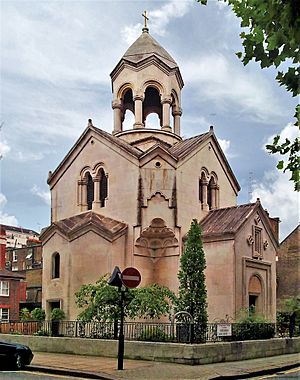
He built the St Sarkis Armenian Church in Kensington, London, England. It was built in 1922–23 as a tribute to his parents. Gulbenkian wanted to offer "spiritual comfort" and a meeting place for Armenians living far from their homeland.
In 1929, he was the main supporter for building a large library at the Cathedral of St. James, Jerusalem. This is the main church of the Armenian Patriarchate of Jerusalem. The library is called the Gulbenkian Library and has over 100,000 books.
He also made a significant donation to the Surp Pırgiç Armenian Hospital in Istanbul. He gave a large property to the hospital in 1954. He also helped set up a nurses' home at the hospital by selling his wife's jewelry.
From 1930 to 1932, he was the president of the Armenian General Benevolent Union (AGBU), a major Armenian charity. He also helped establish new settlements for Armenian refugees.
Later Life and Legacy
Final Years and Lasting Impact
In 1937, Gulbenkian bought a property near Deauville in France. He called it Les Enclos. It was a peaceful place for him to relax. A famous writer, Saint-John Perse, called him the Sage of Les Enclos.
When World War II began, Gulbenkian had special protection as an economic advisor. He moved to Vichy, France, and later to Lisbon, Portugal, in 1942. He lived in Lisbon until he passed away on July 20, 1955, at the age of 86.
In 1952, he declined a high honor from the British Empire. In the same year, his wife Nevarte died. They had two children, a son named Nubar and a daughter named Rita.
His ashes were buried at the St Sarkis Armenian Church in London, the church he built.
At the time of his death, Gulbenkian's fortune was estimated to be hundreds of millions of US dollars. He left some money to his family. The rest of his fortune and his art collection were given to the Calouste Gulbenkian Foundation. He also set aside money to restore the Etchmiadzin Cathedral, a very important Armenian church.
The foundation was created to support charity, education, arts, and science. In Lisbon, the foundation built its headquarters and the Calouste Gulbenkian Museum (Museu Calouste Gulbenkian) to show his art collection.
There are also rooms and buildings at the University of Oxford named after Gulbenkian, like the Gulbenkian Reading Room.
Awards
 Grand Cross of the Order of Christ (Portugal) – 1950
Grand Cross of the Order of Christ (Portugal) – 1950
Published Works
- La Transcaucasie et la péninsule d'Apchéron; souvenirs de voyage (Transcaucasia and the Absheron Peninsula – Memoirs of a Journey), published in Paris, 1891. .
See also
 In Spanish: Calouste Gulbenkian para niños
In Spanish: Calouste Gulbenkian para niños
- Re Gulbenkian's Settlements
- Calouste Gulbenkian Museum
- Centro de Arte Moderna Gulbenkian (CAM)
- Gulbenkian commission
- Gulbenkian Park
- Gulbenkian Orchestra
- Gulbenkian Science Institute
- Museum of the Year, formerly the Gulbenkian Prize



